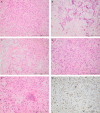H3F3A (Histone 3.3) G34W Immunohistochemistry: A Reliable Marker Defining Benign and Malignant Giant Cell Tumor of Bone
- PMID: 28505000
- PMCID: PMC5510691
- DOI: 10.1097/PAS.0000000000000859
H3F3A (Histone 3.3) G34W Immunohistochemistry: A Reliable Marker Defining Benign and Malignant Giant Cell Tumor of Bone
Abstract
Giant cell tumor of bone (GCTB) is a locally aggressive subarticular tumor. Having recently reported that H3.3 G34W mutations are characteristic of this tumor type, we have now investigated the sensitivity and specificity of the anti-histone H3.3 G34W rabbit monoclonal antibody in a wide variety of tumors including histologic mimics of GCTB to assess its value as a diagnostic marker. We also determined the incidence of H3.3 G34 mutations in primary malignant bone tumors as assessed by genotype and H3.3 G34W immunostaining. A total of 3163 tumors were tested. Totally, 213/235 GCTB (90.6%) showed nuclear H3.3 p.G34W immunoreactivity. This was not the case for the rare variants, p.G34L, M, and V, which occurred most commonly in the small bones of the hands, patella, and the axial skeleton. If these sites were excluded from the analysis, H3.3 G34W expression was found in 97.8% of GCTB. Malignant bone tumors initially classified as osteosarcomas were the only other lesions (n=11) that showed G34W expression. Notably an additional 2 previously reported osteosarcomas with a p.G34R mutation were not immunoreactive for the antibody. A total of 11/13 of these malignant H3.3-mutant tumors exhibited an osteoclast-rich component: when imaging was available all but one presented at a subarticular site. We propose that subarticular primary malignant bone sarcoma with H3.3 mutations represent true malignant GCTB, even in the absence of a benign GCTB component.
Conflict of interest statement
Conflicts of Interest and Source of Funding: Supported by the Medical Research Council grant (MR/M00094X/1). A grant awarded to A.M.F. by the Royal National Orthopaedic Hospital NHS Trust NHS Trust, and the Skeletal Cancer Action Trust (Scat), UK. A.M.F. was supported by the National Institute for Health Research, UCLH Biomedical Research Centre, and the UCL Experimental Cancer Centre. D.B. was supported by the Gertrude von Meissner-Stiftung and the Basel Bone Tumour Reference Centre Foundation. The authors have disclosed that they have no significant relationships with, or financial interest in, any commercial companies pertaining to this article.
Figures



Similar articles
-
H3F3A G34 mutation DNA sequencing and G34W immunohistochemistry analysis in 366 cases of giant cell tumors of bone and other bone tumors.Histol Histopathol. 2021 Jan;36(1):61-68. doi: 10.14670/HH-18-264. Epub 2020 Sep 4. Histol Histopathol. 2021. PMID: 33021329
-
Diagnostic utility of histone H3.3 G34W, G34R, and G34V mutant-specific antibodies for giant cell tumors of bone.Hum Pathol. 2018 Mar;73:41-50. doi: 10.1016/j.humpath.2017.11.020. Epub 2017 Dec 12. Hum Pathol. 2018. PMID: 29241742
-
H3F3A mutation in giant cell tumour of the bone is detected by immunohistochemistry using a monoclonal antibody against the G34W mutated site of the histone H3.3 variant.Histopathology. 2017 Jul;71(1):125-133. doi: 10.1111/his.13190. Epub 2017 Apr 10. Histopathology. 2017. PMID: 28211081
-
Histone H3.3 mutation in giant cell tumor of bone: an update in pathology.Med Mol Morphol. 2020 Mar;53(1):1-6. doi: 10.1007/s00795-019-00238-1. Epub 2019 Nov 20. Med Mol Morphol. 2020. PMID: 31748824 Review.
-
H3F3A mutation as a marker of malignant giant cell tumor of the bone: A case report and review of literature.J Cancer Res Ther. 2023 Apr-Jun;19(3):832-834. doi: 10.4103/jcrt.jcrt_247_21. J Cancer Res Ther. 2023. PMID: 37470622 Review.
Cited by
-
The Activation of PDGFRβ on Mononuclear Stromal/Tumor Cells in Giant Cell Tumor of Bone After Denosumab Treatment. An Immunohistochemical Study of Five Cases.Pathol Oncol Res. 2022 Aug 24;28:1610633. doi: 10.3389/pore.2022.1610633. eCollection 2022. Pathol Oncol Res. 2022. PMID: 36091939 Free PMC article.
-
Rare features of giant cell tumors of the bone: A case report.Exp Ther Med. 2024 Aug 28;28(5):409. doi: 10.3892/etm.2024.12698. eCollection 2024 Nov. Exp Ther Med. 2024. PMID: 39268365 Free PMC article.
-
Diagnostic tools in the differential diagnosis of giant cell-rich lesions of bone at biopsy.Oncotarget. 2018 Jul 10;9(53):30106-30114. doi: 10.18632/oncotarget.25725. eCollection 2018 Jul 10. Oncotarget. 2018. PMID: 30046391 Free PMC article.
-
Poorly differentiated cutaneous squamous cell carcinoma with osteoclast-like giant cell: A rare, aggressive variant.Clin Case Rep. 2019 Jan 9;7(2):340-342. doi: 10.1002/ccr3.1955. eCollection 2019 Feb. Clin Case Rep. 2019. PMID: 30847202 Free PMC article.
-
Malignancy in giant cell tumor of bone in the extremities.J Bone Oncol. 2020 Nov 5;26:100334. doi: 10.1016/j.jbo.2020.100334. eCollection 2021 Feb. J Bone Oncol. 2020. PMID: 33251099 Free PMC article.
References
-
- Athanasou NA, Bansal M, Forsyth R, et al. Fletcher C, Bridge J, Hogendoorn P, et al. Giant cell tumour of bone. WHO Classification of Tumours of Soft Tissue and Bone. Lyon, France: IARC Press; 2013:321–324.
-
- Errani C, Ruggieri P, Asenzio MA, et al. Giant cell tumor of the extremity: a review of 349 cases from a single institution. Cancer Treat Rev. 2010;36:1–7. - PubMed
-
- Forsyth R, Jundt G.Fletcher CDM, Bridge JA, Hogendoorn PCW, et al. Giant cell lesion of the small bones. WHO Classification of Tumours of Soft Tissue and Bone. Lyon, France: IARC Press; 2013:320.
-
- Al-Ibraheemi A, Inwards CY, Zreik RT, et al. Histologic spectrum of giant cell tumor (GCT) of bone in patients 18 years of age and below: a study of 63 patients. Am J Surg Pathol. 2016;40:1702–1712. - PubMed
MeSH terms
Substances
Grants and funding
LinkOut - more resources
Full Text Sources
Other Literature Sources
Medical

